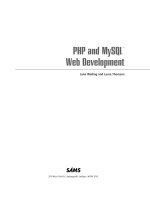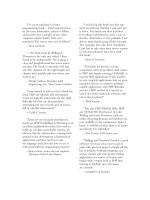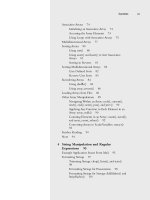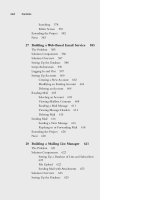PHP and MySQL Web Development - P117 pdf
Bạn đang xem bản rút gọn của tài liệu. Xem và tải ngay bản đầy đủ của tài liệu tại đây (66.66 KB, 5 trang )
552
Chapter 25 Building a Shopping Cart
<tr>
<td>Description:</td>
<td><textarea rows="3" cols="50"
name="description">
<?php echo $edit?$book['description']:''; ?>
</textarea></td>
</tr>
<tr>
<td <?php if (!$edit) echo 'colspan="2"'; ?> align="center">
<?php
if ($edit)
// we need the old isbn to find book in database
// if the isbn is being updated
echo '<input type="hidden" name="oldisbn"
value="'.$book['isbn'].'">';
?>
<input type="submit"
value="<?php echo $edit?'Update':'Add'; ?> Book">
</form></td>
<?php
if ($edit)
{
echo '<td>';
echo '<form method="post" action="delete_book.php">';
echo '<input type="hidden" name="isbn"
value="'.$book['isbn'].'">';
echo '<input type="submit"
value="Delete book">';
echo '</form></td>';
}
?>
</td>
</tr>
</table>
</form>
<?php
}
If we pass in an array containing the book data, the form will be rendered in edit mode
and will fill in the fields with the existing data:
<input type="text" name="price"
value="<?php echo $edit?$book['price']:''; ?>">
We even get a different submit button. In fact, for the edit form we get two—one to
update the book, and one to delete it.These call the scripts edit_book.php and
delete_book.php, which update the database accordingly.
Listing 25.19 Continued
31 525x ch25 1/24/03 3:39 PM Page 552
553
Using an Existing System
The category versions of these scripts work in much the same way except for one
thing.When an administrator tries to delete a category, it will not be deleted if any
books are still in it. (This is checked with a database query.) This avoids any problems we
might get with deletion anomalies.We discussed these in Chapter 7,“Designing Your
Web Database.” In this case, if a category was deleted that still had books in it, these
books would become orphans.We wouldn’t know what category they were in, and we
would have no way of navigating to them!
That’s the overview of the administration interface. For more details, refer to the
code—it’s all on the CD-ROM.
Extending the Project
We have built a fairly simple shopping cart system.There are many additions and
enhancements we could make:
n
In a real online store, you would need to build some kind of order tracking and
fulfillment system—at the moment, there’s no way to see the orders that have been
placed.
n
Customers want to be able to check the progress of their orders without having to
contact you.We feel that it is important that a customer does not have to log in to
browse. However, providing existing customers a way to authenticate themselves
gives them the ability to see past orders, and gives you the ability to tie behaviors
together into a profile.
n
At present, the images for books have to be FTPed to the image directory and
given the correct name.You could add file upload to the book insertion page to
make this easier.
n
You could add user login, personalization, and book recommendations; online
reviews; affiliate programs; stock level checking; and so on.The possibilities are
endless.
Using an Existing System
If you want to get a highly featured shopping cart up and running quickly, you might
want to try using an existing shopping cart system. One well known Open Source cart
implemented in PHP is FishCartSQL, available from
/>This has a lot of advanced features such as customer tracking, timed sales, multiple lan-
guages, credit card processing, and support for multiple online shops on one server. Of
course, when you use an existing system, you always find there are things that it does not
have that you want, and vice versa.The advantage of an Open Source product is that you
can go in and change the things you don’t like.
31 525x ch25 1/24/03 3:39 PM Page 553
554
Chapter 25 Building a Shopping Cart
Next
In the next chapter, we’ll look at how to build an online content management system
suitable for managing digital assets—this can be useful if you are running a content-
based site.
31 525x ch25 1/24/03 3:39 PM Page 554
26
Building a Content Management
System
IN THIS CHAPTER
,WE’
LL LOOK AT A content management system for storing, indexing,
and searching text and multimedia content.
Content management systems are extremely useful on Web sites where the site con-
tent is maintained by more than one author, where maintenance is performed by non-
technical staff, or where the content and graphic design are developed by different peo-
ple or departments.
We will build an application that helps authorized users to manage an organization’s
digital assets.
We will cover the following:
n
Presenting Web pages using a series of templates
n
Building a search engine that indexes documents according to metadata
The Problem
Let’s imagine that the busy Web development team for SuperFastOnlineNews consists of
an excellent graphic designer and some award-winning writers.The site contains regu-
larly updated news, sports, and weather pages.The main page shows the latest headline
from each of the three category pages.
At SuperFastOnlineNews, the designers ensure that the Web site content looks great.
This is what they do best.Writers, on the other hand, write excellent articles, but can’t
draw well or build Web sites.
We need to allow everyone to concentrate on what they are best at and bring their
output together to provide the super fast news service that the name implies.
32 525x ch26 1/24/03 3:38 PM Page 555
556
Chapter 26 Building a Content Management System
Solution Requirements
We need to produce a system that
n
Increases productivity by having the writers concentrate on writing and the
designers on designing
n
Allows the editor to review stories and decide which ones should be published
n
Presents a consistent look and feel throughout the site using page templates
n
Allows writers access only to their designated areas of the site
n
Enables the look and feel to be easily changed for a section or throughout the site
n
Prevents live content from being changed
Editing Content
First, we need to think about how we will get content into the system, and how we will
store and edit that content.
Getting Content into the System
We need to decide on a way that stories and design components will be submitted.
Three possible methods can be used.
FTP
The writers and designers could be given FTP access to areas on the Web server, and
they could then upload files from their local machine to the server.There would need to
be a rigid naming standard for the uploaded files (to identify which pictures belonged to
which stories) or a Web-based system to deal with this separately from the FTP upload.
Using FTP also creates issues with permissions in this situation. Because of the flexi-
bility required by this example, we will not be using FTP to allow users to upload files.
File Upload Method
As we discussed in Chapter 16,“Interacting with the File System and the Server,” the
HTTP protocol provides a method for files to be uploaded via the Web browser. PHP is
able to deal with this very easily.
The file upload method also gives us the opportunity to store text in a database rather
than as a file.To do this, we would read in the temporary file and store its contents in
the database, rather than copying it to another place in the file system.We will not use
file upload for stories in this project.
We will discuss the superiority of a database over the file system later.
Editing Online
We can let users create and edit documents without using either FTP or file upload.
Instead you can give the contributors a large text area input box onscreen in which their
story content can be edited.
32 525x ch26 1/24/03 3:38 PM Page 556









